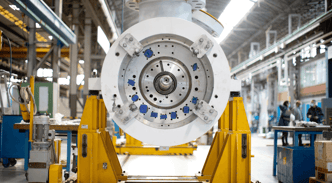Turbo Machinery – The power behind the plant
Turbo machinery equipment such as compressors and expanders form the backbone of the air separation method as they pump cooled or heated air through an ASU facility, fuelling its division into its constituent elements. However, there is more to the technology than air alone – the systems are also used in a flowering LNG market. We talked to leading designers and manufacturers ACD, Mafi Trench and CryoMachinery (part of Air Products) to ask, what powers innovation for machinery makers?
Keep your customers close
Tom Gerhard is director of Turbo Machinery at ACD. The company has been part of the Cryogenic Industries group for nearly 25 years, manufacturing cryogenic turbo expanders and pumps for the industrial gas market. Gerhard said ACD’s turbo product range includes compressor loaded as well as air brake and oil brake loaded units.
He begins by giving us the quick technical lowdown saying, $quot;The turbo expander provides the primary refrigeration for gas separation and liquefication. It does this by removing the energy from the high pressure gas stream, cooling the gas that provides the refrigeration for the plant.
He continues, $quot;ACD is a leader in this industry. We work closely with our customers’ process engineers to meet the needs of their new systems. Our customers know that we have a range of equipment that satisfies their requirements and when necessary, we can innovate a new design.$quot;
He says the key to ACD’s succes is this relationship, $quot;we stay close to make sure we can best assist in new applications and improving existing ones.$quot;
Gerhard sees the market moving towards improvements in mechanical reliability and increased performance. $quot;Customers are performance-focused. We design to give their systems reliability while maintaining the performance they demand.$quot;
Bigger capacities, smaller costs
Darren Prosser works in Sales and Business development for CryoMachinery, part of Air Products. He says as a result of their affiliation with the industrial gas giant his business areas has, $quot;received continuous feedback on our equipment over the last 64 years resulting in very high efficiency, high reliability expansion equipment that is perfectly suited for end-customer needs.$quot;
Their product range includes centrifugal companders (expanders with compressor on common shaft) and expanders, which are either generator loaded, dissipative, or integrated. Generator-loaded expanders either utilize a speed reduction gearbox and a low speed generator, or in some cases utilize direct-drive technology. Dissipative expanders are either oil-loaded or blower loaded. Integrated expanders are integrated onto plant main air compressors.
Prosser explains that they have, $quot;a broad range of customers from all regions of the world.$quot; These include large petrochemical companies, industrial gas companies, individual plant owners and operators such as ExxonMobil, Shell, Air Liquide, Air Products and Chemicals, BOC and many others.
He goes on to explain the breadth of his products usage saying, $quot;some of the major market segments that our equipment is used in include air separation and industrial gases (N2, O2, Ar), Helium recovery, hydrogen and CO Production, LNG base load production and GTL (gas to liquid) and there are many others.$quot;
This experience of working in a number of fields, specifications and markets puts Mr. Prosser in a good position to tell us a little about the direction of the turbo machinery market. He believes, $quot;Trends have been towards both smaller and larger turbines. Larger turbines are in increasing demand for mega-ASU, LNG, waste heat recovery, and petrochemical applications. Smaller microturbines are in demand for smaller on-site and distributed applications.$quot;
In the future he believes we may see more of integrated equipment systems as well as more packaging with larger systems to minimize field construction costs. He predicts, $quot;Further refinement of inverse design methods and continued integration of design and estimating tools should result in reduced engineering effort for new designs and shorter product design times.$quot; Finally he echoes the common theme across the industry – the only way is up. He says we should see, $quot;Further advances in materials of construction allowing higher speeds and larger direct drive generator loaded expanders.$quot;
Looking long term on LNG
Joe Lillard is the vice president of Technology with another part of Cryogenic Industries – California based Mafi Trench. He explains that the company’s speciality product is the turbo expander but unlike our other contributors they work specifically in hydrocarbon processes.
His company’s interests are, $quot;mainly natural gas processing and petrochemical processing.$quot; The process here is similar to ASU systems, however, the outcome is different. He says, $quot;in natural gas processing the turbo expanders are used to produce low temperatures that is required to take the liquid out of the natural gas – i.e. the propane, butane etc.$quot;
The company offers a full range of services to their customers, who then place Mafi-Trench products in projects around the world. He explains, $quot;most of our customers are the EPC’s (the engineering, procurement and constructions companies – they buy the product which is then installed in plants owned by all the major oil companies, petrochemical companies, etc.$quot;
A recent project for the firm has been the largest natural gas processing plant in the world now being built in Saudi Arabia, called the Haiyah project. Lillard says, $quot;We supplied six very large turbo expander compressors to the plants builders.$quot; In addition to this mammoth project it seems bigger is better in most areas of Mafi Trench’s core market at the moment. Lillard explains, $quot;the expanders used in natural gas processing have grown in size to handle up to and over 1bn square cubic foot per day in a single train.$quot;
Other developments of note have included, $quot;the integration of magnetic bearings,$quot; says Lillard. The bearings offer a high level of reliability compared to oil loaded or gas based systems, though across the board expander designers have told us that whichever you choose reliability is high.
Lillard says, $quot;Unlike a hot machine such as a gas turbine, expanders are a very reliable piece of equipment. These machines can run for a long time before they need maintenance. Some of our original machines are still running.$quot;
Jumping from the past to the future Lillard offered his thoughts on how the machinery market may yet develop. He says a currently little-used piece of equipment; the expander generator is sparking a lot of interest.
He explains that the units, $quot;are used when you are still extracting the power from the process in the same way as a regular expander but instead of using it (the energy) elsewhere in the process for compression you are converting this power to electric power by using the expander to drive an electric generator.$quot; The technology is not new but it’s popularity, $quot;goes up and down according to the price of energy.$quot; It seems with prices high this is definitely a system we might be seeing more of.
... to continue reading you must be subscribed









